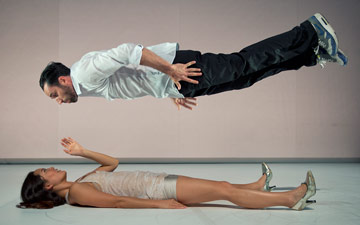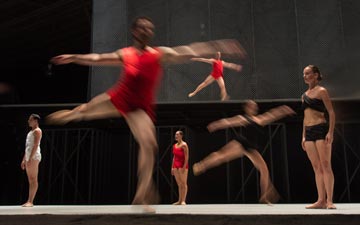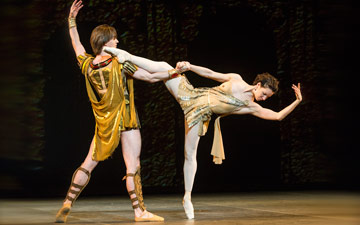
© Nils Schlebusch. (Click image for larger version)
Maya Beiser + Wendy Whelan + Lucinda Childs + David Lang
The Day
★★★✰✰
New York, Joyce Theater
24 October 2019
www.lucindachilds.com
www.wendywhelan.org
www.mayabeiser.com
davidlangmusic.com
www.joyce.org
Remembrance of Things Past
The pairing of prestigious participants does not always guarantee success – a lesson learned again and again in the theater. On paper, The Day, the result of a collaboration between the composer David Lang, the cellist Maya Beiser, the dancer Wendy Whelan, and the choreographer Lucinda Childs, sounds promising. True, the unspoken subject matter – life, death, the afterlife, the inconsolable tragedy of 9/11 – does give one pause. Very few works of art are able to meaningfully comment on or offer solace when it comes to such matters. But the problems with The Day, I think, run deeper.
The Day has two parts, both set to works composed by David Lang for Maya Beiser, a classical cellist with a rockstar stage presence and a discography that abounds in works in which she layers loops of sound on multiple tracks. As explained in the program, World To Come was written in the aftermath of the destruction of the Twin Towers. It is, as one would imagine, the more intense and dissonant of the two pieces, from the slashing chords with which it begins, to vibrating glissandi and a repeated four-note figure around which are layered various crashing waves of sound. Beiser adds the sound of her breath and vocalizations. The first section, The Day, which was written much later, in 2016, is more lyrical, more hopeful. In addition to the simple, legato melodies of Beiser’s cello, the piece is punctuated by a woman’s voice speaking short phrases. Lang drew these phrases from internet searches, each of which began with the phrase “I remember the day.”
As these mantra-like phrases unspool, black and white film images are projected: Whelan and Beiser’s faces, a bank of large windows, Santiago Calatrava’s Oculus building at the World Trade Center. The film design is by Joshua Higgason, lighting by Natasha Katz, scenic design by Sara Brown. Beiser plays her cello on a small platform, outlined in white; Whelan occupies the opposite side of the stage, her area similarly delineated. For some reason I was reminded of the set of Martha Graham’s mythological Errand Into the Maze. In the first half of the evening, Whelan handles various props: rope, an elastic band, two long, thin sticks. She is dressed in white, like a goddess or an angel, and moves with seraphic calm. Then, in the second half, the two women switch places. Now they are dressed in black. There are more recognizable dance steps, and fewer props until, at the end, a white curtain descends from the flies, like a ray of hope, or a tower, or a veil. This section begins with dramatic projected images of a cello being thrown down and fracturing into a million pieces.

© Nils Schlebusch. (Click image for larger version)
Whelan is never less than elegant, sculptural, and totally absorbed. As in her days as a principal dancer at New York City Ballet, she has a way of elevating whatever material she performs, infusing it with honesty and objectivity. She doesn’t over-dramatize. I was particularly struck by the way she handled the two long sticks, creating clear, limpid geometries. With her aquiline profile and linear shape, she resembles work of human architecture. Form as function. In the early section, she wears a white toga-like garment (designed by Karen Young), which she stretches and drapes across her body, emphasizing the geometries of her slender frame. Again, shades of Martha Graham.
Beiser, for her part, plays her instrument with verve and conviction. In a way, she is the star of the show; these musical pieces were written for her and her playing is dramatic, full-throttle. She revels in the material, and in the experience of creating and inhabiting this world of sound. I wasn’t completely convinced, however, that the sonic environment was actually as interesting as her absorption in it suggested. With its repetitions and continuous waves, and its lack of dynamic contrast, the hour-long evening felt significantly longer.
Childs’s choreography for Whelan is spare: bending, lunging, pulling on ropes, stretching an elastic into various shapes. In the second half, there are allusions to balletic movement: a foot to the knee, creating a triangular shape, arms held open, hands and fingers gracefully arranged. Whelan gives each shape and moment its full value. But her integrity isn’t enough to make this collaboration feel like more than the sum of its parts.

















You must be logged in to post a comment.